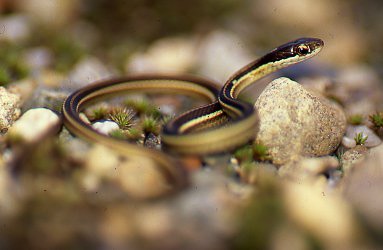
Ribbonsnake. Note white cresent mark in front of eye and brown tint below side stripe.
This is a snake that’s usually not far from wetlands — lake, pond, marsh, or stream. It may be found most commonly in shrub swamps and marshes from spring to late summer. However, this snakes' status is Massachusetts is not clear. Report any observations.
I have seen Ribbonsnakes in autumn on rocky forested hillsides, along railroad beds, and on boulder fields at reservoirs where they are probably overwintering. There’s no evidence that I’m aware that they spend the winter in and around water, but somebody should try and get inside a beaver lodge to find out for sure! Or a muskrat burrow. Or any other place for that matter!

If you look at the lower side stripe it is higher on the body than in gartersnakes; in fact it’s on scale rows 3 and 4 counting from the ventrals (the large scales on the underside of a snake in the photo below). The lateral stripe in gartersnakes is on scale rows 2 and 3, often blending with the yellow color of the ventral scales.

Ribbonsnake lateral stripe on scales rows 3 and 4, counting from the lower ventral scales
Being semi-aquatic, Ribbonsnakes feed mostly on frogs (all sizes and life stages), small fish, aquatic insects, salamander (all sizes and life stages), and perhaps other animals.

Ribbonsnake in early spring


